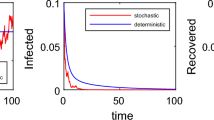Summary
Co-and superinfection of cells with T3/T7 result in exclusion (mutual or superinfection exclusion). The exclusion mechanism is also directed against homologous (or identical) virus. Exclusion is established after the adsorption but before the genome becomes available for gene expression or replication, that is only one virus per cell develops. The exclusion is triggered by a constituant of the viral particle. An early T7 gene (M gene) (Schweiger et al., 1975) is essential for the formation of exclusion competent virions.
Similar content being viewed by others
References
Adams, M.H., Wade, E.: Classification of bacterial viruses: The relationship of two Serratia phages to coli-dysentery phages T3, T7 and D44. J. Bact. 68, 320–325 (1954)
Anderson, C.W., Williamson, J.R., Eigner, J.: Localization of parental deoxyribonucleic acid from superinfecting T4 bacteriophage in Escherichia coli. J. Virol. 8, 887–893 (1971)
Benzer, S.: Resistance to ultraviolet light as an index to the reproduction of bacteriophage. J. Bact. 63, 59–72 (1952)
Delbrück, M., Bailey, Jr., W.T.: Induced mutations in bacterial viruses. Cold Spr. Harb. Symp. quant. Biol. 11, 33–37 (1946)
French, R.C., Graham, A.F., Lesly, S.M., van Rooyen, C.E.: The contribution of phosphorus from T2r+ bacteriophage to progeny. J. Bact. 64, 597–607 (1952)
Hausmann, R.: Synthesis of an S'-adenosylmethionine-cleaving enzyme in T3-infected Escherichia coli and its disturbance by co-infection with enzymatically incompetent bacteriophage. J. Virol. 1, 57–63 (1967)
Hausmann, R.L., Almeida-Magllhāes, E.P., Araujo, C.: Isolation and characterization of hybrids between bacteriophages T3 and T7. An. Microbiol. Univ. Brasil (Rio de J.) 9, 511–526 (1961)
Hausmann, R.L., Almeida-Magalhāes, E.P., Araujo, C.: Intracellular compatibility of coliphages T3, T7 and Cro. An. Microbiol. Univ. Brasil (Rio de J.) 10, 43–62 (1962)
Herrlich, P., Rahmsdorf, H.J., Schweiger, M.: Regulation of macromolecular synthesis by membrane changes. Adv. Biosci. 12, 523–537 (1974)
Hill, R.F.: A radiation-sensitive mutant of Escherichia coli. Biochem. biophys. Acta (Amst.) 30, 636–637 (1958)
Hyman, R.W., Brunovskis, I., Summers, W.C.: A biochemical comparison of the related bacteriophages T7, φI, φII, W31, H, and T3. Virology 57, 189–206 (1974)
Luria, S.E.: Reactivation of irradiated bacteriophage by transfer of self-reproducing units. Proc. nat. Acad. Sci. (Wash) 33, 253–264 (1947)
Munyon, W., Kit, S.: Inhibition of thymidine kinase formation in LM (TK−) cells simultaneously infected with Vaccinia and a thymidine kinaseless Vaccinia mutant. Virology 26, 374–377 (1965)
Parkinson, J.S., Huskey, R.J.: Deletion mutants of bacteriophage Lambda. J. molec. Biol. 56, 369–384 (1971)
Ponta, H., Altendorf, K.-H., Schweiger, M., Hirsch-Kauffmann, M., Pfennig-Yeh, M., Herrlich, P.: E coli membranes become permeable to ions following T7-virus-infection. Molec. gen. Genet. (1976)
Ponta, H., Pon, C.L., Herrlich, P., Gualerzi, C., Hirsch-Kauffmann, M., Pfennig-Yeh, M., Rahmsdorf, H.J., Schweiger, M.: The sex-factor-dependent exclusion of coli virus T7. Europ. J. Biochem. 59, 261–270 (1975)
Ponta, H., Rahmsdorf, H.J., Pai, S.H., Hirsch-Kauffmann, M., Herrlich, P., Schweiger, M.: Control of gene expression in bacteriophage T7: Transcriptional controls. Molec. gen. Genet. 134, 281–297 (1974)
Schweiger, M., Hirsch-Kauffmann, M., Ponta, H., Pfennig-Yeh, M., Herrlich, P.: Biochemistry of T7 development. In: Organisation and expression of the viral genome, FEBS Symposium, Vol. 39, pp. 55–68. Amsterdam: North-Holland 1975
Simon, M.N., Studier, F.W.: Physical mapping of the early region of bacteriophage T7 DNA. J. mol. Biol. 79, 249–265 (1973)
Studier, F.W.: The genetics and physiology of bacteriophage T7. Virology 39, 562–574 (1969)
Studier, F.W.: Gene 0.3 of bacteriophage T7 acts to overcome the DNA restriction system of the host. J. molec. Biol. 94, 283–295 (1975)
Susskind, M.M., Botstein, D., Wright, A.: Superinfection exclusion by P22 prophage in lysogens of Salmonella typhimurium (III. Failure of superinfecting phage DNA to enter sieA+ lysogens). Virology 62, 350–366 (1974)
Wood, W.B.: Host specificity of DNA produced by Escherichia coli: Bacterial mutations affecting the restriction and modification of DNA. J. molec. Biol. 16, 118–133 (1966)
Author information
Authors and Affiliations
Additional information
Communicated by E. Bautz
Rights and permissions
About this article
Cite this article
Hirsch-Kauffmann, M., Pfennig-Yeh, Ml., Ponta, H. et al. A virus-specified mechanism for the prevention of multiple infection—T7- and T3-mutual and superinfection exclusion. Molec. Gen. Genet. 149, 243–249 (1976). https://doi.org/10.1007/BF00268524
Received:
Accepted:
Issue Date:
DOI: https://doi.org/10.1007/BF00268524




